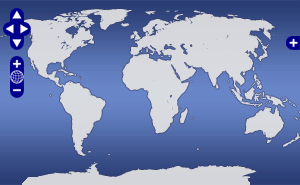Residual mantle Bouguer gravity anomaly data (netCDF format) in a corridor across the Mid-Atlantic Ridge at 24°-27°N
Shipboard free-air gravity data from R/V Ewing Cruises EW9208 and EW9606 in the Mid-Atlantic Ridge corridor at 24°-27°N were processed as described by Wang et al. (2015) to the obtain Residual Mantle Bouguer Anomaly (RMBA): The gravitational effects of seafloor topography and relief on the crust-mantle interface were subtracted from the free-air gravity anomaly to obtain mantle Bouguer anomaly (MBA), assuming a reference crustal thickness of 6 km and using the spectrum method of Parker (1973). Densities of water, crust, and mantle were assumed to be 1.03 10^3, 2.7 10^3, and 3.3 10^3 kg m^-3, respectively. RMBA was then calculated by removing the gravitational effect of lithospheric cooling from MBA, based on a 3-D mantle thermal model. The mantle thermal structure was calculated for a 100 km thick layer, using the 2-D age grid of Wang et al. (2015) and assuming simple 1-D plate cooling (Turcotte and Schubert, 2002; Wang et al., 2011). The parameters used in the calculation are the same as in Wang et al. (2011). This mantle thermal model was then converted to a 3-D mantle density structure, which was used to calculate gravitational effects. Note that, within a narrow axial region that contains ridge-axis offsets, this 1-D plate cooling model differs slightly from the 3-D passive mantle upwelling model used in Tucholke et al. (1997), in which lateral heat transfer across ridge offsets was considered. Thus, the calculated thermal structure and resultant gravity corrections for the 3-D passive upwelling model are smoother across ridge offsets than those predicted by the 1-D plate cooling model. However, differences between the two models are only a few mGal and are limited to a narrow zone proportional to the size of ridge offsets. The file presented here is in GMT-compatible netCDF grid format. Additional gravity and other shipboard data in this region are available at https://doi.org/10.26025/z2z7-kd89. Ewing Cruise EW9208 was funded by Office of Naval Research grant N00014-90-J-6121, and Ewing Cruise EW9606 was funded by National Science Foundation grant OCE-9503561.
Tucholke, Brian
Investigator
WHOI
Lin, Jian
Investigator
WHOI
Quality
2
The data have been processed/modified to a level beyond that of basic quality control (e.g. final processed sonar data, photo-mosaics).
License
Data Files
References
Documents
Data Citation Information
ISO/XML Metadata
Expand

 Map View
Map View
